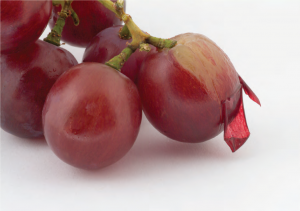Turns out you can judge a wine by its color.
Although wines have myriad and complex properties, perhaps the most obvious can be attributed directly to the skins of their grapes. The basics of wine-making are well known…grapes are picked, then crushed, and the skins either stay in contact with the crush or have little to no contact. Wines can be grouped into three primary categories relative to the skin of the grape: white wines, red wines, and rosés wines.
WHITE WINES are wines that contain little or no red pigmentation. These wines have had little or no interaction with the skins of their grapes as they are processed. White wines are almost always made from white grapes, but they can be made from black grapes as well, because the juice of most black grapes is actually clear. White wines can be sweet or dry, or somewhere in between. Popular white wines include Chardonnay, Pinot Grigio, Pinot Gris, Riesling, and Sauvignon Blanc.
Blanc.
RED WINES are made from black grapes and have a red or blue tint. Since most grapes have colorless juice, red wine needs its grape skins, which contain nearly all of the grapes’ pigmentation, to remain intact along with the juice during all or part of the fermentation process. Tannins, also found in the grape skins, are transferred into the wine while the skins are in contact with the juice. Besides the difference in color, the primary difference between red and white wines has to do with their respective tannins.
Found mainly in red wines, tannins provide a dry, puckery sensation in the mouth and in the back of the throat. They also help preserve wine, allowing most (but not all) red wines to be aged longer than white wines. Popular red wines include Beaujolais, Cabernet Sauvignon, Chianti, Merlot, Pinot Noir and Zinfandel.
ROSÉ WINES are pinkish in color, so they are often referred to as pink or blush wines. Rosés are made from black grapes, but they do not fully turn red because the grape skins are removed from the juice mere hours after initial contact. This brief exposure to the skins gives the wine its signature color through the slight transference of red pigments. Rosés can also be produced by blending white and red wines. This technique also involves brief skin contact, which ensures that a minimal amount of tannins enters the blush wine. Many rosés are sweet, with White Merlot and White Zinfandel serving as typical examples.
The best and most traditional vintages, however, are the European rosés, which tend to be bone dry. Given today’s high-tech instant information resources, grape skin and its extracts have been getting a lot of attention in terms of potential health benefits. Antioxidants, called pycogenols, are present in grape skins. The darker the grapes, the greater concentration of pycogenols, hence the media’s infatuation with the healthful properties of red wine. In the 1950s, these compounds were isolated from grapes and used in the treatment of cirrohosis, varicose veins, and retinopathy (an eye disease attributed to diabetes). As scientific discovery progressed, the researchers were able to isolate reservatrol, the most hyped compound on the market associated with grape skins. Studies have shown reservatrol’s benefits to include: • High potency anti-inflamatory properties • Blood thinning capabilities as good or better than aspirin • May interfere with the development of cancer • Natural anti-fungal agent • Helps to reduce bad cholesterol (LDL) • Can increase good cholesterol (HDL) • Reduces blood pressure.
Now before we all go out and drink massive quantities of red wine to saturate ourselves with reserves of reservatrol, there are some offsetting side effects. In order to enjoy most of reservatrol’s positive health benefits through red wine consumption, we would have to drink red wine practically all day long, every day. Perhaps not a bad idea to some, but our livers would undoubtedly have something to say about this. A further, consideration is that reservatrol is a plant estrogen, which has received much attention as contributing to the proliferation of certain breast cancer cells. Grapes, once an innocent treat we all enjoyed as youngsters, now provide us as grown-ups with the fruit of the vine in its fi nest form—wine, complete with all its trappings, some good, some bad. We can now appreciate that wine is more than just grapes and their juices. It’s got some real skin, too.
Mike Cohen owns the Wine Concierge (www.gourmetwc. com). He specializes in locating hard-to-find wines for customers in New York and New Jersey.





